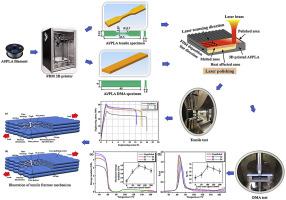当前位置:
X-MOL 学术
›
Polym. Test.
›
论文详情
Our official English website, www.x-mol.net, welcomes your
feedback! (Note: you will need to create a separate account there.)
Effects of laser scanning speed on surface roughness and mechanical properties of aluminum/Polylactic Acid (Al/PLA) composites parts fabricated by fused deposition modeling
Polymer Testing ( IF 5.0 ) Pub Date : 2020-11-01 , DOI: 10.1016/j.polymertesting.2020.106785 Xinzhou Zhang , Lan Chen
Polymer Testing ( IF 5.0 ) Pub Date : 2020-11-01 , DOI: 10.1016/j.polymertesting.2020.106785 Xinzhou Zhang , Lan Chen

|
Abstract Although fused deposition modeling (FDM) has gradually become one of the popular additive manufacturing technologies in different industries, high surface roughness has always been an inevitable disadvantage of FDM parts. Laser polishing represents a recent and novel application of laser surface irradiation that can be used for precise, post-process smoothing of the rough surfaces commonly encountered on FDM parts. The influence of laser polishing on surface modification and mechanical properties of aluminum/Polylactic Acid (Al/PLA) composites has been investigated. Laser scanning speed was varied to evaluate its effect on the surface quality and mechanical properties of the experimental samples. The results indicated that laser polishing could enable reductions in surface roughness of over 86.6% (from 23.27 μm to 3.11 μm Sa). The tensile strength of specimen also increased from 41.01 MPa to 51.31 MPa with increasement of 25.1%. The dynamic mechanical analysis (DMA) results showed that there was a remarkable improvement in the storage modulus and glass transition temperature of Al/PLA composite specimens after laser polishing, which suggested that the laser polishing treatment could play a role in decreasing the porosity inside the FDM parts and improve interfacial adhesion between the PLA matrix and Al fibers. Moreover, the fracture morphologies were observed to investigate the possible strengthening mechanism. These results demonstrate how laser polishing can simultaneously smooth and modify the surface characteristics of a FDM part surface.
中文翻译:

激光扫描速度对熔融沉积成型铝/聚乳酸(Al/PLA)复合材料零件表面粗糙度和力学性能的影响
摘要 尽管熔融沉积成型(FDM)逐渐成为各行业流行的增材制造技术之一,但表面粗糙度高一直是FDM零件不可避免的缺点。激光抛光代表了激光表面辐照的最新和新颖应用,可用于对 FDM 零件上常见的粗糙表面进行精确的后处理平滑处理。研究了激光抛光对铝/聚乳酸(Al/PLA)复合材料表面改性和机械性能的影响。改变激光扫描速度以评估其对实验样品的表面质量和机械性能的影响。结果表明,激光抛光可以使表面粗糙度降低 86.6% 以上(从 23.27 μm 到 3.11 μm Sa)。试样的拉伸强度也从 41.01 MPa 增加到 51.31 MPa,增加了 25.1%。动态力学分析(DMA)结果表明,激光抛光后 Al/PLA 复合材料试样的储能模量和玻璃化转变温度有显着提高,这表明激光抛光处理可以起到降低内部孔隙率的作用。 FDM 部件并提高 PLA 基体和铝纤维之间的界面附着力。此外,观察断裂形态以研究可能的强化机制。这些结果证明了激光抛光如何同时平滑和修改 FDM 零件表面的表面特征。动态力学分析(DMA)结果表明,激光抛光后 Al/PLA 复合材料试样的储能模量和玻璃化转变温度有显着提高,这表明激光抛光处理可以起到降低内部孔隙率的作用。 FDM 部件并提高 PLA 基体和铝纤维之间的界面附着力。此外,观察断裂形态以研究可能的强化机制。这些结果证明了激光抛光如何同时平滑和修改 FDM 零件表面的表面特征。动态力学分析(DMA)结果表明,激光抛光后 Al/PLA 复合材料试样的储能模量和玻璃化转变温度有显着提高,这表明激光抛光处理可以起到降低内部孔隙率的作用。 FDM 部件并提高 PLA 基体和铝纤维之间的界面附着力。此外,观察断裂形态以研究可能的强化机制。这些结果证明了激光抛光如何同时平滑和修改 FDM 零件表面的表面特征。这表明激光抛光处理可以在降低 FDM 部件内部的孔隙率和提高 PLA 基体和铝纤维之间的界面粘附方面发挥作用。此外,观察断裂形态以研究可能的强化机制。这些结果证明了激光抛光如何同时平滑和修改 FDM 零件表面的表面特征。这表明激光抛光处理可以在降低 FDM 部件内部的孔隙率和提高 PLA 基体和铝纤维之间的界面粘附方面发挥作用。此外,观察断裂形态以研究可能的强化机制。这些结果证明了激光抛光如何同时平滑和修改 FDM 零件表面的表面特征。
更新日期:2020-11-01
中文翻译:

激光扫描速度对熔融沉积成型铝/聚乳酸(Al/PLA)复合材料零件表面粗糙度和力学性能的影响
摘要 尽管熔融沉积成型(FDM)逐渐成为各行业流行的增材制造技术之一,但表面粗糙度高一直是FDM零件不可避免的缺点。激光抛光代表了激光表面辐照的最新和新颖应用,可用于对 FDM 零件上常见的粗糙表面进行精确的后处理平滑处理。研究了激光抛光对铝/聚乳酸(Al/PLA)复合材料表面改性和机械性能的影响。改变激光扫描速度以评估其对实验样品的表面质量和机械性能的影响。结果表明,激光抛光可以使表面粗糙度降低 86.6% 以上(从 23.27 μm 到 3.11 μm Sa)。试样的拉伸强度也从 41.01 MPa 增加到 51.31 MPa,增加了 25.1%。动态力学分析(DMA)结果表明,激光抛光后 Al/PLA 复合材料试样的储能模量和玻璃化转变温度有显着提高,这表明激光抛光处理可以起到降低内部孔隙率的作用。 FDM 部件并提高 PLA 基体和铝纤维之间的界面附着力。此外,观察断裂形态以研究可能的强化机制。这些结果证明了激光抛光如何同时平滑和修改 FDM 零件表面的表面特征。动态力学分析(DMA)结果表明,激光抛光后 Al/PLA 复合材料试样的储能模量和玻璃化转变温度有显着提高,这表明激光抛光处理可以起到降低内部孔隙率的作用。 FDM 部件并提高 PLA 基体和铝纤维之间的界面附着力。此外,观察断裂形态以研究可能的强化机制。这些结果证明了激光抛光如何同时平滑和修改 FDM 零件表面的表面特征。动态力学分析(DMA)结果表明,激光抛光后 Al/PLA 复合材料试样的储能模量和玻璃化转变温度有显着提高,这表明激光抛光处理可以起到降低内部孔隙率的作用。 FDM 部件并提高 PLA 基体和铝纤维之间的界面附着力。此外,观察断裂形态以研究可能的强化机制。这些结果证明了激光抛光如何同时平滑和修改 FDM 零件表面的表面特征。这表明激光抛光处理可以在降低 FDM 部件内部的孔隙率和提高 PLA 基体和铝纤维之间的界面粘附方面发挥作用。此外,观察断裂形态以研究可能的强化机制。这些结果证明了激光抛光如何同时平滑和修改 FDM 零件表面的表面特征。这表明激光抛光处理可以在降低 FDM 部件内部的孔隙率和提高 PLA 基体和铝纤维之间的界面粘附方面发挥作用。此外,观察断裂形态以研究可能的强化机制。这些结果证明了激光抛光如何同时平滑和修改 FDM 零件表面的表面特征。









































 京公网安备 11010802027423号
京公网安备 11010802027423号